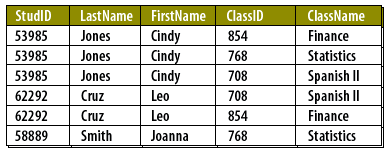| Lesson 10 | Problems with many-to-many Relationships |
| Objective | Describe the Problems with many-to-many Relationships |
Mastering Many-to-Many Relationships in ERD Modeling
When it comes to Entity-Relationship Diagram (ERD) modeling, understanding and managing many-to-many relationships is crucial for accurate and efficient database design. In this article, we'll discuss the challenges a data designer faces when working with many-to-many relationships and provide strategies to overcome them.
Navigating the Complexities of Many-to-Many Relationships
Challenge 1: Redundancy and Inconsistency
One of the main challenges data designers face when dealing with many-to-many relationships is the potential for redundancy and inconsistency. This occurs when two entities share multiple relationships, leading to data duplication and the risk of introducing discrepancies between records.
Solution: Introducing Associative Entities
To resolve the issues of redundancy and inconsistency, introduce an associative entity. An associative entity acts as a bridge between the two main entities, allowing you to store the relationship information separately, thus eliminating redundancy and ensuring consistency.
erDiagram
ENTITY_A ||--o{ ASSOCIATIVE_ENTITY : has
ENTITY_B ||--o{ ASSOCIATIVE_ENTITY : has
Challenge 2: Maintaining Referential Integrity
Maintaining referential integrity is another challenge in many-to-many relationships. Ensuring that related records are consistently updated or deleted can be difficult, especially when multiple relationships exist between the same entities.
Solution: Implementing Cascade Operations
Implement cascade operations in your database to automatically update or delete related records when a change occurs in one of the primary entities. This will help maintain referential integrity by ensuring that changes are consistently reflected across all related entities.
Challenge 3: Query Performance
Many-to-many relationships can also impact query performance. Complex queries involving multiple relationships can lead to slower response times and increased resource usage.
Solution: Indexing and Optimizing Queries
To overcome this challenge, use proper indexing techniques and optimize your queries. Indexes help speed up database searches, while optimizing queries can reduce the number of resources required to execute them.
Enhancing ERD Modeling with Best Practices
To further improve your ERD modeling process and manage many-to-many relationships effectively, consider implementing the following best practices:
1. Normalize Your Database
Normalization is the process of organizing your database to reduce redundancy and improve data integrity. By applying normalization principles, you can streamline your ERD modeling and make it easier to manage many-to-many relationships.
Use Clear Naming Conventions
Adopting clear and consistent naming conventions for your entities, attributes, and relationships will help you maintain a well-structured ERD model. This will make it easier to identify and manage many-to-many relationships in your design.
3. Leverage Entity-Relationship Modeling Tools
Utilize ERD modeling tools to create and visualize your database schema. These tools can help you identify many-to-many relationships, automatically generate associative entities, and ensure your ERD model adheres to best practices.
Managing many-to-many relationships in ERD modeling can be challenging, but by understanding these challenges and applying the solutions and best practices discussed in this article, you can create efficient, accurate, and well-structured database designs. Remember to introduce associative entities, maintain referential integrity, optimize query performance, and leverage ERD modeling tools to overcome the complexities of many-to-many relationships.
Real World Challenges
Many-to-many relationships are disallowed in a relational database because of the problems they create. These include:
Refer again to the Students table below, so that these problems can be put into perspective.
- Data redundancy
- Data insertion, deletion, and updating difficulties
Refer again to the Students table below, so that these problems can be put into perspective.

Note the redundant data[1] in the ClassID field. Similarly, the ClassName field reveals the same classes listed several times. In a university database with a few thousand students taking four or five courses each, this would produce an enormous amount of redundant data in the ClassName field of the Students table.
Why is this a problem? Suppose a new class-naming policy came out and you were required to modify the names of classes (for example, change Spanish I to Introductory Spanish, and change Spanish II to Intermediate Spanish).
First, you would have to be sure to modify the names in both tables, a minor task in the Classes table. But then, you would have to find every instance of both Spanish classes in the Students table and rename them as well, which is not a minor task at all.
Inserting and deleting new records is also problematic because of the duplicate fields in the Students and Classes tables (ClassID and ClassName). With duplicate fields, the same data has to be maintained across both tables.
Data redundancy and the problems it brings disappear when many-to-many relationships are properly resolved.
The next lesson describes how.
Why is this a problem? Suppose a new class-naming policy came out and you were required to modify the names of classes (for example, change Spanish I to Introductory Spanish, and change Spanish II to Intermediate Spanish).
First, you would have to be sure to modify the names in both tables, a minor task in the Classes table. But then, you would have to find every instance of both Spanish classes in the Students table and rename them as well, which is not a minor task at all.
Inserting and deleting new records is also problematic because of the duplicate fields in the Students and Classes tables (ClassID and ClassName). With duplicate fields, the same data has to be maintained across both tables.
Data redundancy and the problems it brings disappear when many-to-many relationships are properly resolved.
The next lesson describes how.
[1]redundant data: Duplicate data in a database; although redundant data can never be totally removed, a major goal of database design is to eliminate as much redundant data as possible.